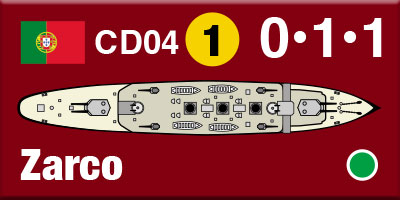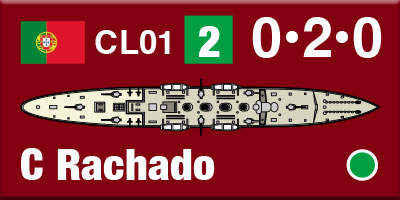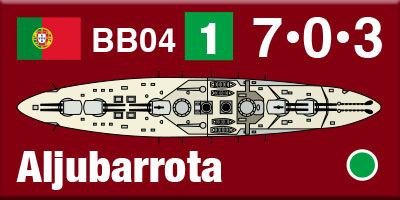| Golden Journal No. 59
Portugal’s Armada
Publisher’s Preview
by Mike Bennighof, Ph.D.
September 2024
 Golden Journal No. 59: Portugal’s Armada is all about the Portuguese Navy in the early decades of the Twentieth Century. Yes, Portugal had a fleet during this period. It wasn’t much of a fleet, built around a small coast-defense “battleship” and a handful of “export” cruisers built by the British Armstrong firm exactly for sale to countries like Portugal, but it did exist. Golden Journal No. 59: Portugal’s Armada is all about the Portuguese Navy in the early decades of the Twentieth Century. Yes, Portugal had a fleet during this period. It wasn’t much of a fleet, built around a small coast-defense “battleship” and a handful of “export” cruisers built by the British Armstrong firm exactly for sale to countries like Portugal, but it did exist.
With the weakest economy in Europe, even that spending represented a financial burden. Portugal had gone bankrupt in 1892 and again in 1902. Under King Dom Carlos I, the economy remained near-comatose, causing widespread street protests and even armed resistance. None of that kept the king’s admirals from dreaming. In 1906, the Royal Portuguese Navy sought proposals from Vickers and Armstrong, the British shipbuilding firms, for a class of small “battleships.” They duly presented competing designs, each with four 12-inch and four 9.2-inch guns.
Some secondary sources call these “dreadnoughts,” but they would have been slow coast-defense ships. And we have them in Portugal’s Armada, two examples. They are not well-armed, nor are they well-protected, but at least they are quite slow.

Even that was apparently too much for the king’s purse, and the 1907 program he approved included two much small, 2,500-ton ships with four 6-inch guns in twin turrets fore and aft. They shared the weak protection and armament of the bigger ships, and their utter lack of speed. But they were relatively inexpensive.
That program would never come to pass, either, as assassins gunned down Dom Carlos in February 1908 as the royal family rode through Lisbon in an open carriage. The first shots killed the king. His eldest son, Dom Luis, pulled out a hidden revolver and exchanged fire with another assassin who had leapt onto the carriage’s running board. A rifle shot killed the pistol-packing prince, and the would-be killer turned his pistol on the king’s second-eldest son, Dom Manuel. Queen Amélie attacked the man on the running board, newspaper reporter Alfredo Luís da Costa, with the only weapon to hand, a bouquet of flowers. The queen successfully drove him off, but Dom Manuel was not able to staunch his brother’s bleeding. Both the king and crown prince died on the scene.

The 1907 naval program died with Dom Carlos. The 19-year-old Dom Manuel ascended to the throne, lasting only until 1910, when a republican revolution (originating in a mutiny aboard the cruiser Dom Carlos I) drove the royal family into British exile.
Dom Manuel fled just as the new Brazilian dreadnought São Paulo had dropped anchor at Lisbon for a state visit. On her first cruise following completion in Britain, the spanking-new battleship had Brazilian President Hermes Rodrigues da Fonseca aboard, who dined with the young king and then offered asylum aboard the battleship. Dom Manuel declined, and the Brazilians refused to allow the revolutionaries to search for him aboard the ship.

São Paulo made an enormous impression on the public, and on the new revolutionary regime, led by the Portuguese Republican Party. That a former colony could build such a splendid ship highlighted the crapulent state into which Portugal had fallen. As a symbol of the new Republic’s revival, Portugal needed a ship just like her.
Prestige-envy prompted the lust for dreadnoughts, but there were other justifications offered. The PRP government faced the same domestic challenges as had the royal regime, and saw two vital threats on the international front: that Spain would take advantage of Portugal’s instability to invade and annex the country, and that foreign predators would strip away the Portuguese colonial empire. The answer to these problems would be a powerful fleet; government opponents pointed out that such spending would also serve to increase the very instability that created the international problems in the first place.

At that point, the British government stepped in to guarantee ₤20 million in loans to cover a Portuguese military buildup. The Portuguese returned to Vickers and Armstrong in 1911, seeking fresh dreadnought designs. Armstrong Design 702 displaced 19,750 tons, with ten 12-inch guns in five twin turrets, all along the centerline, and twenty 4.7-inch guns. She looked a great deal like a smaller version of current British super-dreadnought designs. She would have had an armored belt of 9.25 inches, and a top speed of 21.5 knots.
Vickers offered the nearly-identical Design 504, with slightly less displacement, armor, and speed (and one assumes, a slightly lesser price tag. They also submitted a variant, Design 505, with eight 13.5-inch guns in four twin turrets and fourteen 6-inch guns on a very similar hull. The Vickers Design 702 appears to have been the favorite, and that’s the ship included in Portugal’s Armada.

The program would also include modern light cruisers, destroyers, auxiliaries, and submarines. But at some point, the PRP leadership realized that acceptance of the huge British loan would effectively end Portuguese independence when the republic inevitably defaulted on payments. That would likely lead to a loss of the colonial empire, an unacceptable outcome. And so, the program was scaled back to one led by a pair of cruisers built in British yards, and four destroyers built in Lisbon with British assistance. That could hopefully be funded on Portuguese revenues, but no orders had been placed for the cruisers when the First World War erupted in August 1914, though the destroyers were eventually completed.
Portugal joined the war on the side of the Allies, sending two infantry divisions to fight on the Western Front where they suffered 14,000 casualties out of 60,000 men engaged. The Portuguese Navy hoped to receive a share of the German High Seas Fleet after the war, but this was never in the cards even before the Germans scuttled their own fleet, and Portugal instead added six former Austro-Hungarian torpedo boats to her Armada.

One more possibility appeared in July 1921, when the U.S. Navy’s Second Battleship Squadron visited Lisbon, with the dreadnought Utah attached and its own three Connecticut-class pre-dreadnoughts. Portuguese naval and political leaders toured the ships, including President Antonio José de Almeida. During a formal dinner, squadron commander Charles Frederick Hughes passed along an offer from his government to sell Utah and five Connecticut-class ships. Once again, the Portuguese passed due to the costs. Even so, all six ships placed on the table by Hughes are included in Portugal’s Armada so you can place them on your own game table.

Portugal’s Armada comes with 23 die-cut and silky-smooth playing pieces (17 long ones and six square ones). We tell you all about the ships, the story of the Portuguese Navy, and then we have scenarios so you can play with them in Great War at Sea: Jutland 2e.
The Golden Journal is only available to the Gold Club (that’s why we call it the Golden Journal).
Click here to join the Gold Club.
See your Gold Club Insider newsletter for ordering information.
Sign up for our newsletter right here. Your info will never be sold or transferred; we'll just use it to update you on new games and new offers.
Mike Bennighof is president of Avalanche Press and holds a doctorate in history from Emory University. A Fulbright Scholar and NASA Journalist in Space finalist, he has published a great many books, games and articles on historical subjects; people are saying that some of them are actually good.
He lives in Birmingham, Alabama with his wife, three children, and new puppy. He misses his lizard-hunting Iron Dog, Leopold.
Want to keep Daily Content free of third-party ads? You can send us some love (and cash) through this link right here.
|
